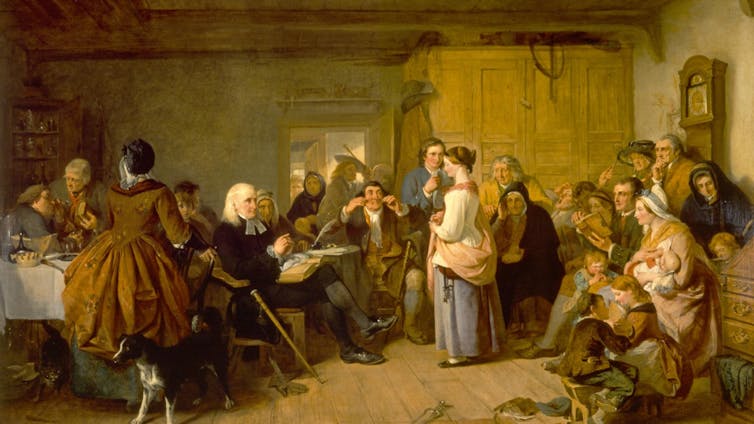Source: The Conversation – UK – By Tony Milligan, Teaching Associate, University of Sheffield

Beyond the race for scientific, commercial and military purposes, there is another space race of a more curious sort. A race to be the first to send various objects up there. But why?
In December 2024, Buddhist monks from Japan attempted unsuccessfully to send a small temple on board a satellite into orbit. The rocket did make it more than 110km from Earth, making it the first time the Dainichi Nyorai (the Buddha of the Cosmos) and the mandala were transported into outer space. The monks hope to try again in the future.
The space temple is only about the size of a medium Amazon delivery box, and covered in protective gold tinted foil. Buddha sits in a special compartment on top. The idea is that, with a growing number of Japanese people living outside of Japan, prayers for departed loved ones could be beamed up to the Buddha as he passes overhead.
Being the first matters. Humans appear to have an innate preference for being first, even being more likely to pick the first options in a list. It is tempting to explain this by appeal to what the Austrian medical doctor Alfred Adler called the “inferiority complex” – a need to keep proving ourselves.
Yet it may simply be an evolutionary trait of a sort which was genuinely useful in the past but has spilled over into more curious modern preferences, such as expecting more of a first born child or voting for the first candidate on the list.
What’s more, through what the biologist Ernst Mayr called the “founder effect”, first movers exercise a disproportionate influence on what happens later on.
Mayr’s original idea was about population genetics and how founders of a population of organisms can restrict later diversity. But the idea has since been applied more broadly to explain why those who arrive or act first tend to have a disproportionate influence on later agents.
Seen in that light, it makes perfect sense that people want to be the first to send something into space. But the choice of objects sent is not always so obvious. Or rather, there is a sliding scale that runs from understandable to downright odd.
Immortality, nostalgia and aliens
At the understandable end of the scale, we have the remains of humans, pets and even dinosaurs. Not large pieces, just bits of hair or ashes.
A company called Celestis has been sending ashes and DNA into space since 1994. In 1997, it sent the fragmentary cremated remains of 24 people, including Star Trek creator Gene Roddenbery, on what was called the “Founders Flight”. It was the first memorial flight into space.
Five years later, the remains unintentionally de-orbited. Yet even with this accidental burn-up, relatives may feel that their loved ones have achieved an immortality of sorts. After all, they were the first.
Something similar applies to pets. A failed launch in January 2024 included more of Gene Roddenberry and partial remains of a dog called Indica-Noodle Fabiano.
Memorialising the dead in space is particularly popular. Even the Apollo 15 mission left a fallen astronauts memorial plaque at Hadley Rille on the Moon in 1971.
Similarly, we have, on several occasions, sent dinosaur bones temporarily into orbit. Inclusion of a T.rex fragment on a 2014 NASA Orion flight was justified “as a reminder of how much life Earth had seen during its existence”.
This reveals a deeper, more emotional reason for why we want to send stuff to space. Coupled with the quest of being first, such items can be proxies for immortality.
They can also be born out of nostalgia. Why else would we want past life on Earth to leave a continuing trace?
Other items are harder to understand. In December, a company called beingAI is planning on having a nickel disk delivered to the Moon. The disk will be imprinted with a digital image of a trainee AI Buddhist priest called Emi Jido.
There aren’t just Buddhist messages in space. For example, the Russian segment of the International Space Station contains all manner of Orthodox religious iconography
But what’s the point of having religious messages in space when there’s no-one there to read them? This reveals yet another intention: we hope that eventually a message will travel far enough to reach another life form.
Making a mark
Similarly, there is little obvious sense in the transmission of Poetica Vaginal, a weak signal of converted vaginal contractions transmitted in the direction of the Eridanis constellation by the Massachusetts Institute of Technology in 1986. The US Air Force, which was in control of the ground facility, quickly intervened before a stronger transmission could be sent.
And it is frankly odd that an invitation to a performance of Klingon opera was sent to Arcturus in the Boötes constellation in 2010, with the invitation written in Klingon (a fictional language from Star Trek). Rather than a representative message from our culture, this came close to cosmic misinformation.
In the best-known case of strange objects sent to space, Elon Musk launched his cherry-red Tesla Roadster sports car in 2018, complete with a mannequin in the driver’s seat, and David Bowie’s Space Oddity blaring on the car radio. Currently, it is around 248 million km from Earth.
These things may reveal yet another reason for why we send stuff to space that is less about immortality, nostalgia, communicating with aliens, or being first. Objects which appear pointless in their own right are still a statement of intent. It is like someone putting a towel on a deckchair that you are not ready to use, but will return to later.
Space infrastructure will ultimately depend on mining the asteroid belt between Mars and Jupiter. And the orbit of Musk’s Roadster crosses and recrosses the orbit of Mars as it travels around the Sun.
Indeed, we know that the Moon, Mars and some little distance beyond could be important parts of humanity’s near future. Not just for science, commerce and military applications, but also for our civilisation as a whole.
We haven’t quite figured out what we are going to do with all of this space, and how we will eventually fill it with our humanity. The curious objects that we send can also be seen as a statement of intent to use the locations where they end up, even if the use remains unspecified.
![]()
Tony Milligan received funding from the European Research Council (ERC) under the European Union’s Horizon 2020 research and innovation programme (Grant agreement No. 856543).
– ref. The other space race: why the world is obsessed with sending objects into orbit – https://theconversation.com/the-other-space-race-why-the-world-is-obsessed-with-sending-objects-into-orbit-265264












